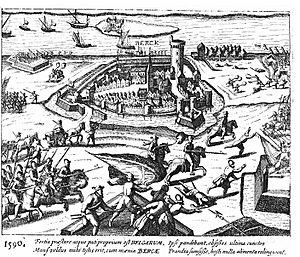Siege of Rheinberg (1586–1590) facts for kids
Quick facts for kids Siege of Rheinberg (1586–1590) |
|||||||
|---|---|---|---|---|---|---|---|
| Part of the Eighty Years' War and the Cologne War | |||||||
 The Siege of Rheinberg of 1590 by Peter Ernst von Mansfeld. |
|||||||
|
|||||||
| Belligerents | |||||||
(Gebhard Truchsess) |
|||||||
| Commanders and leaders | |||||||
(From 1590) |
|||||||
The Siege of Rheinberg (1586–1590) was a long military event. It happened in Rheinberg, a town in what is now Germany. This town was very important because it was a main crossing point over the Rhine river. The siege lasted from August 13, 1586, to February 3, 1590.
This conflict was part of several bigger wars happening at the time. These included the Eighty Years' War, the Cologne War, and the Anglo-Spanish War (1585–1604). The Spanish army, led by Alexander Farnese, Duke of Parma, wanted to take control of Rheinberg.
The town was defended by a group of soldiers who supported the Protestant side. These soldiers were from the United Provinces (like the Netherlands) and Kingdom of England. Important commanders like Maarten Schenck van Nydeggen and Sir Francis Vere tried to help the town. However, after a long fight, the Protestant defenders finally gave up to the Spanish forces. This meant the Spanish won control of Rheinberg.
Contents
Rheinberg's Importance
Rheinberg was a key location during these wars. It was part of the Electorate of Cologne, which was a powerful area. Controlling Rheinberg meant controlling a major way to cross the Rhine River. This was important for moving armies and supplies.
The Long Siege Begins
The Spanish forces first started to surround Rheinberg in 1586. This was not a full attack at first, but more like blocking the town. They wanted to stop supplies from getting in and out. This blocking lasted for a long time, until September 1589.
Spanish Attack in 1589
In late 1589, the Spanish army decided to launch a full siege. Alexander Farnese, Duke of Parma, who was a top Spanish commander, sent a large force. This force was led by Peter Ernst, Count of Mansfeld. Their goal was to capture Rheinberg completely.
Defenders and Commanders
The soldiers defending Rheinberg were mostly Protestant. They fought hard to keep the town.
- Maarten Schenck van Nydeggen was a key commander for the defenders. He tried to help Rheinberg, but he died in August 1589 during a different battle.
- After Schenck's death, Sir Francis Vere took over command in 1590. He also tried to relieve the town, meaning he tried to break the Spanish siege.
The Outcome
Despite the efforts of the defenders and their commanders, the Spanish army was too strong. The Protestant soldiers inside Rheinberg could not hold out any longer. They surrendered to the Spanish on February 3, 1590. This marked a victory for Spain in this important location.
Later Events at Rheinberg
Rheinberg continued to be a battleground even after this siege.
- In 1597, the Dutch army, led by Maurice of Nassau, captured Rheinberg again.
- However, the very next year, in 1598, the Spanish Army of Flanders took it back. They forced the Dutch soldiers to surrender.
See also
- Cologne War
- Army of Flanders
- Destruction of Neuss
- Assault on Nijmegen (1589)
- List of Archbishop-Electors of Cologne

